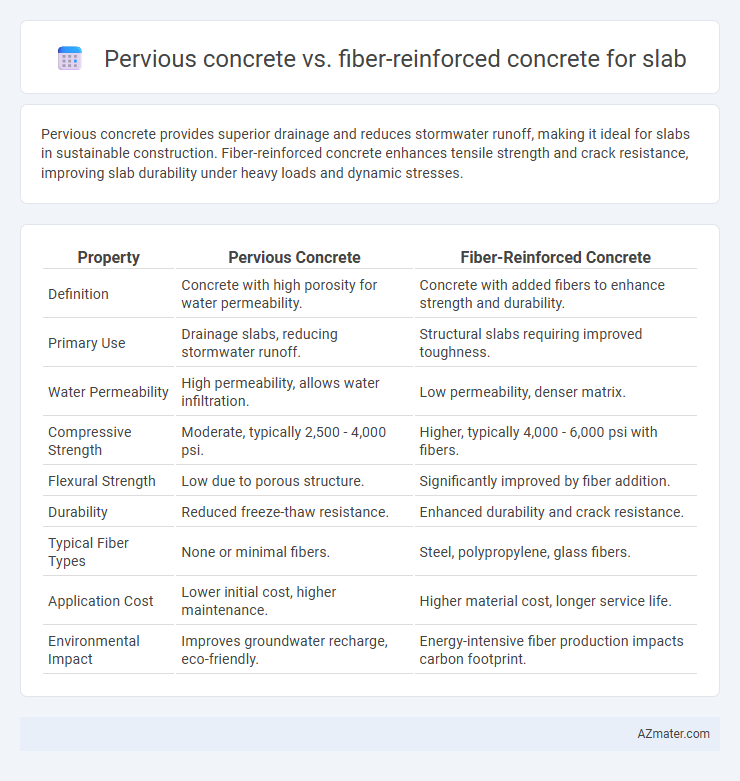Pervious concrete provides superior drainage and reduces stormwater runoff, making it ideal for slabs in sustainable construction. Fiber-reinforced concrete enhances tensile strength and crack resistance, improving slab durability under heavy loads and dynamic stresses.
Table of Comparison
| Property | Pervious Concrete | Fiber-Reinforced Concrete |
|---|---|---|
| Definition | Concrete with high porosity for water permeability. | Concrete with added fibers to enhance strength and durability. |
| Primary Use | Drainage slabs, reducing stormwater runoff. | Structural slabs requiring improved toughness. |
| Water Permeability | High permeability, allows water infiltration. | Low permeability, denser matrix. |
| Compressive Strength | Moderate, typically 2,500 - 4,000 psi. | Higher, typically 4,000 - 6,000 psi with fibers. |
| Flexural Strength | Low due to porous structure. | Significantly improved by fiber addition. |
| Durability | Reduced freeze-thaw resistance. | Enhanced durability and crack resistance. |
| Typical Fiber Types | None or minimal fibers. | Steel, polypropylene, glass fibers. |
| Application Cost | Lower initial cost, higher maintenance. | Higher material cost, longer service life. |
| Environmental Impact | Improves groundwater recharge, eco-friendly. | Energy-intensive fiber production impacts carbon footprint. |
Introduction to Pervious and Fiber-Reinforced Concrete
Pervious concrete is a highly porous material designed to allow water to pass through, reducing runoff and enhancing stormwater management in slabs. Fiber-reinforced concrete integrates synthetic or steel fibers to improve tensile strength, crack resistance, and durability of slabs under heavy loads. Both materials offer specialized solutions for slabs: pervious concrete improves environmental sustainability, while fiber-reinforced concrete enhances structural performance.
Material Composition and Properties
Pervious concrete consists of a mixture of cement, coarse aggregates, and little to no fine aggregates, resulting in a porous structure that promotes water permeability and reduces runoff. Fiber-reinforced concrete incorporates synthetic or steel fibers within the cement matrix, significantly enhancing tensile strength, crack resistance, and durability. While pervious concrete excels in permeability and environmental benefits, fiber-reinforced concrete provides superior mechanical performance and toughness for slab applications.
Structural Performance Comparison
Pervious concrete offers excellent permeability and drainage but generally exhibits lower compressive strength and reduced abrasion resistance compared to fiber-reinforced concrete, making it less suitable for heavy-load slabs. Fiber-reinforced concrete enhances tensile strength, toughness, and crack resistance due to the inclusion of synthetic or steel fibers, resulting in improved durability and structural integrity under dynamic and impact loads. Structural performance of slabs is significantly improved with fiber reinforcement, especially in terms of load-bearing capacity and flexural strength, whereas pervious concrete prioritizes environmental benefits over high structural performance.
Durability and Longevity
Pervious concrete enhances water drainage and reduces surface runoff but typically exhibits lower compressive strength and durability compared to fiber-reinforced concrete, which incorporates synthetic or steel fibers to improve crack resistance and extend slab lifespan. Fiber-reinforced concrete slabs demonstrate superior longevity under heavy load conditions due to enhanced tensile strength and reduced shrinkage cracking. Selecting fiber-reinforced concrete results in a more durable, long-lasting slab ideal for high-traffic or structural applications, whereas pervious concrete suits applications prioritizing permeability over ultimate durability.
Permeability and Drainage Capabilities
Pervious concrete offers superior permeability and drainage capabilities due to its high porosity, allowing water to pass through and reducing surface runoff effectively. Fiber-reinforced concrete, while enhancing tensile strength and durability, generally has lower permeability because fibers reduce the interconnected voids within the matrix. For slab applications requiring efficient stormwater management, pervious concrete is preferable to improve drainage and mitigate flooding risks on pavements.
Load-Bearing Capacity for Slab Applications
Pervious concrete offers moderate load-bearing capacity suitable for light to medium slab applications, emphasizing permeability and stormwater management. Fiber-reinforced concrete significantly enhances load-bearing capacity and tensile strength, improving slab durability under heavy loads and reducing cracking. For high-performance slab applications requiring superior structural integrity, fiber-reinforced concrete provides a more robust solution compared to pervious concrete.
Installation Methods and Constructability
Pervious concrete installation requires careful placement and minimal compaction to maintain its porous structure, using methods like screeding followed by gentle rolling to promote water permeability. Fiber-reinforced concrete slabs involve standard concrete pouring techniques but require thorough mixing to evenly distribute fibers, ensuring enhanced tensile strength and crack resistance. Both materials demand skilled labor, but pervious concrete's sensitivity to weather conditions and mix design heightens constructability challenges compared to fiber-reinforced concrete's more conventional workflow.
Maintenance Requirements
Pervious concrete requires regular cleaning to prevent clogging and maintain its permeability, making routine maintenance essential for effective water drainage in slabs. Fiber-reinforced concrete generally demands less frequent maintenance since fibers enhance crack resistance and structural durability, reducing repair needs. Selecting between these types depends on the expected slab usage and maintenance capacity to ensure long-term performance.
Environmental Impact and Sustainability
Pervious concrete significantly enhances stormwater management and reduces urban heat islands by allowing water infiltration, thus supporting groundwater recharge and minimizing runoff pollution. Fiber-reinforced concrete improves structural durability and reduces crack propagation, extending slab lifespan and decreasing material consumption and associated carbon emissions over time. Both materials contribute to sustainable construction, with pervious concrete prioritizing ecological benefits and fiber-reinforced concrete enhancing resource efficiency and longevity.
Cost Analysis and Economic Considerations
Pervious concrete generally incurs higher initial costs due to specialized materials and installation techniques but offers long-term savings through reduced stormwater management expenses and improved regulatory compliance. Fiber-reinforced concrete slabs typically present moderate initial costs, enhancing durability and reducing maintenance and repair frequency, which translates to lower life-cycle costs. Economic considerations should weigh upfront investment against longevity, maintenance needs, and environmental impact for both materials in slab applications.

Infographic: Pervious concrete vs Fiber-reinforced concrete for Slab
 azmater.com
azmater.com